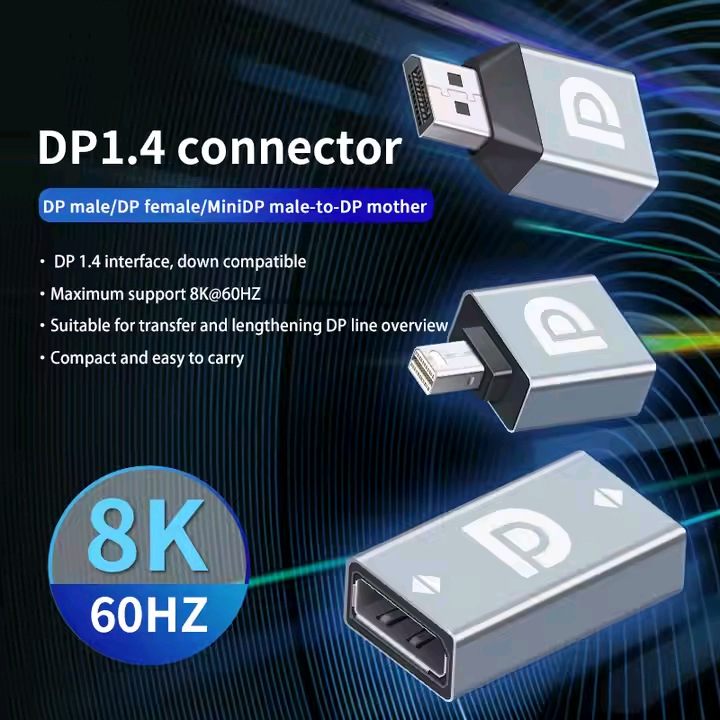Why Choosing the Right Converter Matters
When it comes to connecting various devices, whether it’s a display, projector, or gaming console, selecting the right converter is crucial. With the wide variety of converters available, from HDMI to DisplayPort converters, knowing how to choose the best option can save you time and money while ensuring optimal performance. As an HDMI converter factory, we provide insights into choosing converters that meet your specific needs. In this guide, we’ll walk you through the key factors to consider when selecting converters for your devices.
Understanding the Different Types of Converters
When selecting a converter, understanding the types of connections available is essential. HDMI, DisplayPort, VGA, DVI, and USB-C are common video and audio connectors used across devices. The most common converters in the market are HDMI converters and DisplayPort converters, each serving different purposes.
HDMI Converter
An HDMI converter is designed to convert HDMI signals into different formats, such as VGA, DVI, or DisplayPort. These converters are widely used due to HDMI’s versatility and widespread use in televisions, projectors, and gaming consoles.
DisplayPort Converter
Conversely, a DisplayPort converter is designed to convert DisplayPort signals into other formats, including HDMI or VGA. It is particularly useful for connecting computers and workstations to devices with HDMI or VGA inputs. As a DisplayPort converter supplier, we understand the importance of these converters for businesses relying on high-resolution, high-performance displays.
Knowing the purpose of your device and the types of connections required will help guide your choice between HDMI and DisplayPort converters.
Assessing Compatibility with Your Devices
Before choosing a converter, assess the compatibility of your devices. Different devices have varying port configurations. For example, some modern laptops only have DisplayPort or USB-C, while older projectors might only support VGA or HDMI.
If your device has HDMI output but needs to connect to a monitor that only accepts DisplayPort, a reliable DisplayPort converter can bridge the gap seamlessly. Alternatively, if you’re using a projector that only accepts VGA, an HDMI converter can facilitate the connection.
As an HD converter factory, we emphasize the importance of checking the port types on both your source and target devices. Always ensure that your converter supports the input and output formats required. This consideration will ensure the best performance and avoid issues such as signal loss or reduced quality.
Determining the Resolution and Refresh Rate Requirements
One of the critical aspects to consider when choosing a converter is the resolution and refresh rate compatibility. Different converters support different resolutions, ranging from 1080p to 4K or even higher.
For example, if you need to connect a 4K HDMI source to a DisplayPort monitor, make sure the DisplayPort converter supports 4K resolution at the desired refresh rate. Higher resolution converters may require additional bandwidth and advanced chipsets to maintain a clear signal with minimal lag.
As an HD converter factory, we always recommend ensuring that the converter’s specifications match the needs of your devices. For gaming, video production, or high-end computing, selecting a converter that supports 4K or even 8K resolutions is essential for a smooth experience. If you are using a high-refresh-rate monitor (such as 120Hz or 144Hz), ensure that your converter supports that refresh rate as well.
Understanding the Signal Type and Quality
Another essential factor when choosing a converter is the signal type—whether it is analog or digital. HDMI and DisplayPort are both digital signal interfaces, which offer higher quality and faster data transmission compared to analog signals.
However, when using converters, the quality of the signal can be impacted if the converter isn’t designed to maintain signal integrity. This is especially true when converting between HDMI to VGA or DisplayPort to VGA, where the signal must be converted from digital to analog.
As a DisplayPort converter supplier, we recommend opting for digital-to-digital converters (such as HDMI to DisplayPort or DisplayPort to HDMI) for the best image and sound quality. Converters that maintain the digital signal will provide sharper visuals and clearer audio without introducing unnecessary noise or distortion.
Evaluating the Build Quality and Durability
Durability is an often-overlooked factor when selecting a converter. If you’re using converters in a professional setting, such as in presentations, classrooms, or businesses, you need devices that can withstand frequent use without compromising performance. Look for converters that feature strong materials, such as high-quality plastic or metal housing, which provide protection against physical damage.
As an HD converter factory, we know that the internal components also matter. The converter should be designed with high-quality chips and connectors that ensure long-lasting functionality and reduce the likelihood of signal degradation over time. Be sure to check product reviews and manufacturer specifications to ensure the converter’s durability and longevity.
Conclusion
Making the Right Choice for Your Devices
Choosing the right converter is a balancing act between compatibility, performance, and reliability. Whether you are selecting an HDMI converter for a simple connection or a more complex DisplayPort converter, understanding your device’s specific requirements will guide you in making an informed decision.
As a DisplayPort converter supplier and HD converter factory, we strive to provide converters that meet the highest standards in terms of quality and performance. Always ensure compatibility with your devices, consider the resolution and refresh rate needs, and choose a converter with solid build quality. By following these steps, you’ll find the perfect converter that enhances your device setup and maximizes performance.

